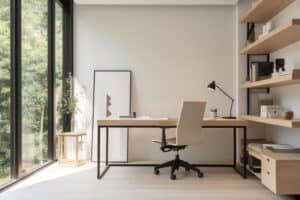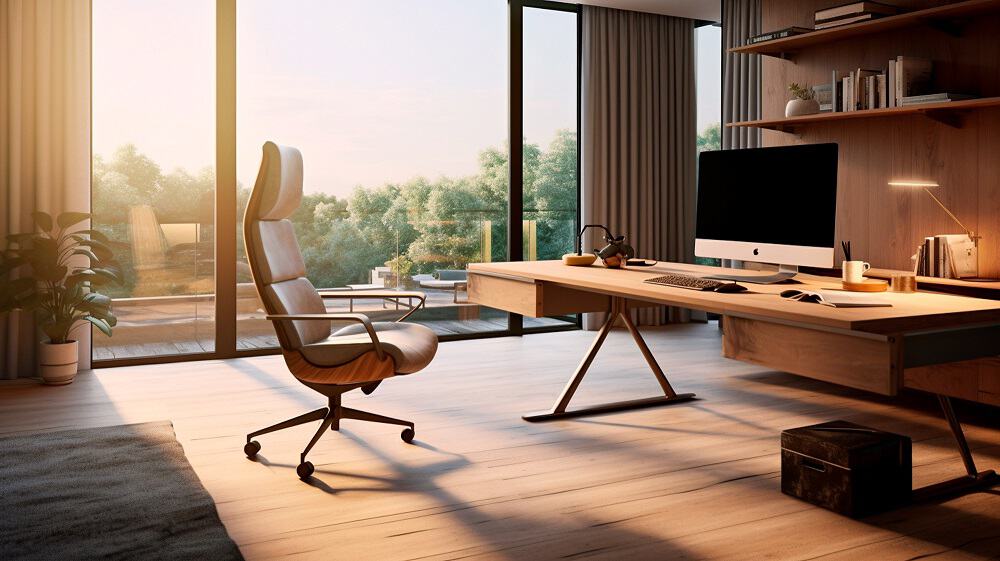In today’s digital era, the prominence of remote work has skyrocketed, elevating the home office from an occasional luxury to an indispensable part of many individuals’ daily lives.
However, designing a productive home workspace that also prioritizes physical well-being isn’t as straightforward as picking out a desk and chair. It demands meticulous equipment selection focused on your health and a deep understanding of ergonomics.
- Importance Of Quality In Seating Choices
When it comes to office chairs, the spectrum is vast. What truly sets the best apart from the mediocre is the inclusion of quality materials for office chairs. These materials not only extend the chair’s durability but also provide the support your body craves.
Considering the hours you’ll sit on this chair, the quality of materials becomes paramount in terms of comfort, adjustability, and holistic ergonomic experience. Opting for cheaper materials might save you some change initially, but the potential health costs down the line can be significant.
True ergonomics focuses on supporting the body’s natural posture. When a chair employs premium materials, it molds to you, eliminating your need to fit it. Such support dramatically decreases the risk of musculoskeletal issues often associated with non-ergonomic environments.
- Adjustable Desks: The Future Of Workspaces
Traditional desks can soon turn into sources of discomfort. This is where adjustable desks come into play. Shifting between sitting and standing throughout your day can boost your energy, productivity, and overall health.
Endless sitting isn’t what your body prefers. Standing desks counterbalance the problems of prolonged sitting, but moderation is vital; standing all day isn’t recommended either.
When in the market for an adjustable desk, prioritize those that transition seamlessly and can support all your essential tools. Stability is necessary, especially when the desk is fully extended.
- Keyboard And Mouse: Tools Of The Trade
Although often overlooked, your keyboard and mouse are crucial. Using non-ergonomic variants can lead to issues like carpal tunnel syndrome. With their unique V-shape, Ergonomic keyboards allow your hands to rest naturally, reducing stress.
This concept carries over to mice. An ergonomic mouse rests snugly in your hand, diminishing wrist strain. The result? Fewer repetitive strain injuries and increased comfort.
Remember, positioning matters. Your keyboard and mouse should allow your elbows to maintain a nearly 90-degree angle during use.

- Monitor Placement Is Key
Your monitor’s placement can shape your workday. Ideally, the top of the screen should align with or just below your eye level, minimizing neck strain.
Monitor distance also plays a role. A too-close monitor might strain your eyes, while one placed too far might make you lean forward, throwing off your posture.
Be wary of glare. Place your monitor, so windows lie to the side, not directly ahead or behind, to protect your eyes and ensure optimal visibility.
- Proper Lighting: Easing Eye Strain
The importance of lighting shouldn’t be underestimated. Dark settings strain the eyes. While natural light reigns supreme, LEDs or daylight bulbs are suitable alternatives.
Avoid direct overhead lights that create shadows. Use task lighting that focuses on your workspace, providing adequate illumination without overwhelming your eyes. And pay attention to blue light filters; they’re a worthy investment against digital eye fatigue.
- Footrests And Flooring
Your feet deserve ergonomic consideration, too. A proper footrest elevates your feet, encouraging better posture and reducing leg strain.
Flooring selection matters. While hard surfaces might look sleek, they can be punishing, especially if you’re standing. Consider anti-fatigue mats to cushion your stance and relieve pressure.
- Cable Management: More Than Aesthetic
A tangle of cables might seem merely aesthetic, but it can pose safety risks. A neat arrangement not only cleans up your space but can prevent accidents.
From basic ties to intricate cable trays, various solutions can help keep those cables in line. After all, a clean office often equates to a productive one.
- Plants And Air Quality
Air quality can subtly affect your productivity and health. Plants do more than just beautify; they cleanse the air, extracting impurities and enhancing overall air quality.
Several studies suggest that indoor plants can bolster productivity, alleviate stress, and inspire creativity. For a hassle-free touch of nature, consider low-maintenance plants like snakes or spiders.
- Breaks And Movement
Despite having top-notch ergonomics, our bodies weren’t designed to remain static. Regular interruptions for stretches and movement are vital. Set timers to remind you to stand, walk, or stretch every so often.
These breaks refresh both body and mind, sparking creativity and enhancing problem-solving capabilities. It’s about working efficiently, not just hard.
In Conclusion
Building an ergonomic home office is more than just following current trends. It’s a pledge to your health, productivity, and overall well-being.
By emphasizing seating quality, flexible workspace arrangements, and elements that bolster physical and mental health, you’re paving the way for a workspace that truly serves you. As your professional life evolves, ensure your workspace follows suit, always with a focus on health and comfort.

Recent Comments